Many readers ask the following question: "What does "AMP!" stand for in Zotac's overclocked cards?" They usually use suffixes to hint at overclocking (Turbo, SuperTurbo, Overclocked, etc). But it's hard to make out what AMP means. We believe these letters might be the beginning of "amplifier".
Once upon a time there was PC Partner company, a big friend of ATI, because family ties are the strongest in Chinese business. Then one CEO retired, the other one passed away. And companies started to drift apart. Besides, ATI started to experience product problems in 2005, and NVIDIA got an advantage.
Long long ago it was PC Partner that manufactured reference cards for ATI. But then the Chinese giant got fed up with being in the shadow and came to light by sponsoring a subsidiary named "Sapphire". Thus, PC Partner continued to make cards under the new brand. Despite being a subsidiary, Sapphire was an independent company that just used PC Partner's manufacturing facilities. Then the latter wanted to try making NVIDIA-based products as well, because the Californian company gained more popularity. However, Sapphire was still manufacturing only ATI (AMD) solutions. Thus, Zotac appeared -- PC Partner had created another company. But this time it was not independent like Sapphire, it belonged to PC Partner completely.
We've already examined a lot of products from this company. And today we shall test two more overclocked AMP! cards.
Graphics Cards
| Zotac GeForce GTX 280 AMP! 1024MB |
- GPU: GeForce GTX 280 (GT200)
- Interface: PCI-Express x16
- GPU frequencies (ROPs/Shaders): 700/1400 MHz (nominal -- 600/1300 MHz)
- Memory frequencies (physical (effective)): 1150 (2300) MHz (nominal -- 1100 (2200) MHz)
- Memory bus width: 512bit
- Vertex processors: -
- Pixel processors: -
- Unified processors: 240
- Texture processors: 80 (BLF/TLF)
- ROPs: 32
- Dimensions: 270x100x33 mm (the last figure is maximum thickness of the graphics card).
- PCB color: black
- RAMDACs/TDMS: in a separate NVIO chip.
- Output connectors: 2xDVI (Dual-Link/HDMI), TV-out.
- VIVO: not available
- TV-out: integrated into GPU.
- Multi-GPU operation: SLI (Hardware).
|
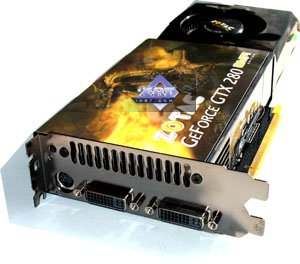 |
| Zotac GeForce GTX 260 AMP! 896MB |
- GPU: GeForce GTX 260 (GT200)
- Interface: PCI-Express x16
- GPU frequencies (ROPs/Shaders): 650/1400 MHz (nominal -- 575/1240 MHz)
- Memory frequencies (physical (effective)): 1050 (2100) MHz (nominal -- 1000 (2000) MHz)
- Memory bus width: 448bit
- Vertex processors: -
- Pixel processors: -
- Unified processors: 192
- Texture processors: 64 (BLF/TLF)
- ROPs: 24
- Dimensions: 270x100x33 mm (the last figure is maximum thickness of the graphics card).
- PCB color: black
- RAMDACs/TDMS: in a separate NVIO chip.
- Output connectors: 2xDVI (Dual-Link/HDMI), TV-out.
- VIVO: not available
- TV-out: integrated into GPU.
- Multi-GPU operation: SLI (Hardware).
|
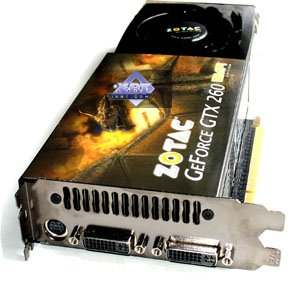 |
| Zotac GeForce GTX 260 AMP! 896MB |
| The graphics card has 896 MB of GDDR3 SDRAM allocated in 14 chips (seven chips on each side of the PCB.) Hynix memory chips (GDDR3). These memory chips are designed for the maximum frequency of 1200 (2400) MHz. |
 |
| Zotac GeForce GTX 280 AMP! 1024MB |
| The graphics card has 1024 MB of GDDR3 SDRAM allocated in 16 chips (eight chips on each side of the PCB.) Hynix memory chips (GDDR3). These memory chips are designed for the maximum frequency of 1200 (2400) MHz. |
 |
| Comparison with the reference design, front view |
| Zotac GeForce GTX 260 AMP! 896MB |
Reference NVIDIA GeForce GTX 260 896MB |
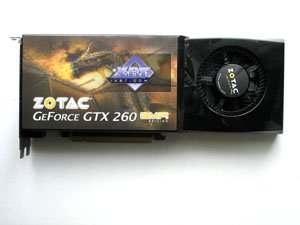 |
 |
| Zotac GeForce GTX 280 AMP! 1024MB |
Reference NVIDIA GeForce GTX 280 1024MB |
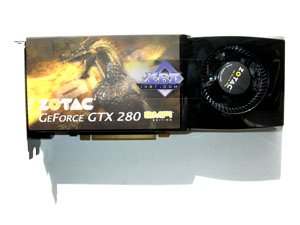 |
 |
| Comparison with the reference design, back view |
| Zotac GeForce GTX 260 AMP! 896MB |
Reference NVIDIA GeForce GTX 260 896MB |
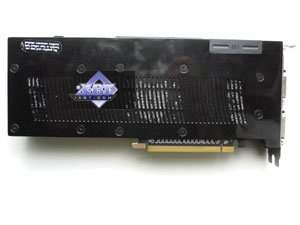 |
 |
| Zotac GeForce GTX 280 AMP! 1024MB |
Reference NVIDIA GeForce GTX 280 1024MB |
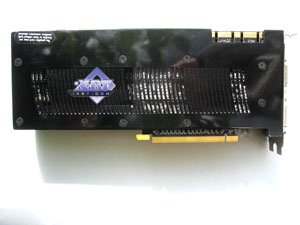 |
 |
There is no need to comment on the design, as both cards are reference products, described in our articles (GTX260, GTX280).
The GTX 260 card is a copy of the GTX 280, but it lacks two memory chips. As a result, the memory bus has shrunk from 512 to 448 bit, and memory size has been decreased from 1024 MB to 896 MB. Besides, the 8-pin power connector is replaced with a usual 6-pin connector (two of them). However, the PCB bears a 512-bit memory exchange bus. Engineers had to arrange 16 memory chips (only 14 chips are installed), which required the double-sided arrangement of the chips (eight chips on each side). So the card is long, and the PCB is quite expensive.
I'll stress the important point once again: The card is 270 mm long, just like the 8800 GTX/Ultra. So a PC case should be large enough to accommodate this device. Besides, width of the housing does not change along the card, so a motherboard should have a zone (30 mm wide) behind PCI-E x16 free of ports or high capacitors, that is not only behind the PCI-E slot, but also behind the neighboring slot.
Graphics cards of this series feature soundcard connectors for transmitting audio stream to HDMI (via a DVI-to-HDMI adapter). That is, the graphics card does not have an audio codec, but it receives audio signal from an external sound card. So, if this feature is important to you, make sure the bundle contains a special audio cable.
Also note that the graphics card uses two power connectors -- two 6-pin connectors on the GTX 260, and 8- and 6-pin connectors on the GTX 280. So, make sure the bundle contains a proper adapter.
The card has TV-Out with an original jack. You will need a special bundled adapter to output video to a TV set via S-Video or RCA.
An analog monitor with a D-Sub (VGA) interface can be connected by means of a special DVI-to-D-Sub adapter. The bundle also includes a DVI-to-HDMI adapter (these graphics cards support video/audio output to HDMI receivers), so there should be no problems with such a monitor.
Maximum resolutions and frequencies:
- 240 Hz maximum refresh rate
- 2048 x 1536 x 32bit @ 85Hz Max - analog interface
- 2560 x 1600 @ 60Hz Max - digital interface (all Dual-Link DVIs)
As of MPEG2 playback (DVD-Video), we analyzed this issue in 2002. Little has changed since that time. CPU load during video playback on modern graphics cards does not exceed 25%.
As of HDTV, a review is available here.
Write a comment below. No registration needed!
